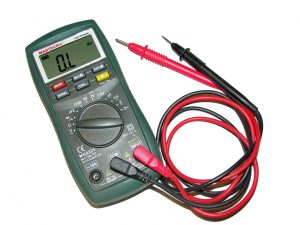To work as an electrician, you need to have a good understanding of Ohm’s law.
With it, you can understand the relations between the three electrical variables: current, voltage, and resistance.
The Principle of Ohm’s Law
Ohm’s law has one rule that you should be familiar with.
The electrical current (I) in a circuit is proportional to the voltage (V) and in inverse proportion to the resistance (R).
This means that as voltage increases, the current will increase, provided that resistance remains constant.
Similarly, as resistance increases, the current will decrease.
In equation form, it will look like this:
V = I ✕ R
where,
V (volts) – the voltage across the conductor
I (amps) – the current flowing through the conductor
R (ohms) – the resistance provided by the conductor to the flow of current
Similarly, if you want to find I or R, you can rewrite the formula to get the answer, as shown below.
To find I:
I = V ÷ R
To find R:
R = V ÷ I
How to Use the Ohm’s Law Formula
Example 1: Solving for the Voltage (V)
You look at the circuit and see the values of two components:
- Current = 4 amps
- Resistance = 3 ohms
Here, you need to find its voltage.
To solve it, we need to use the values we know and work the equation.
V = I ✕ R
V = 4 amps ✕ 3 ohms
V = 12 volts
Example 2: Solving for the Resistance (R)
You need to find the circuit resistance using the following values:
- Voltage = 120 volts
- Current = 17 amps
Now, let’s apply the values to the formula again and work the equation.
R = V ÷ I
R = 120 volts ÷ 17 amps
R = 7.05 ohms
Example 3: Increasing Voltage
You have the following voltages: 120, 240, and 480, with the resistance remaining at 25 ohms.
Find the current for each.
Formula to use: I = V ÷ R
- 120 volts ÷ 25 ohms = 4.8 amps
- 240 volts ÷ 25 ohms = 9.6 amps
- 480 volts ÷ 25 ohms = 19.2 amps
Here, you’ll see that if the voltage increases, the current will increase if the resistance doesn’t change.
Example 4: Increasing Resistance
A circuit has a voltage of 120, with the following resistance: 5, 10, and 20 ohms.
Find the current for each.
Formula to use: I = V ÷ R
- 120 volts ÷ 5 ohms = 60 amps
- 120 volts ÷ 10 ohms = 12 amps
- 120 volts ÷ 20 ohms = 6 amps
Here, if the resistance increases, the current will decrease if the voltage doesn’t change.
Finding the Electrical Power Using Ohm’s Law
You can find how much electrical power there is in a circuit using Ohm’s law.
Power (P, watts) – the rate of energy conversion
We can find P if the values for two components are given, as shown below:
where,
V and I are given, P = V ✕ I
V and R are given, P = V2 ÷ R
I and R are given, P = I2 ✕ R
Ohm’s Law Power Formulas
The Ohm’s law power formulas show the relationship between P, V, I, and R in a circuit where,
P – how much power is being produced
V – how strong is the flow in the circuit
I – how much current is flowing
R – how hard it is for the current to flow
Power
P = V ✕ I
P = I2 ✕ R
P = V2 ÷ R
Voltage
V = I ✕ R
V = √(P ✕ R)
V = P ÷ I
Current
I = V ÷ R
I = √(P ÷ R)
I = P ÷ V
Resistance
R = P ÷ I2
R = V ÷ I
R = V2 ÷ P
How to Use the Ohm’s Law Pie Chart
You can use the Ohm’s law pie chart for reference in calculating P, V, I, and R.
In using it, make sure to follow these steps:
- Know what value you’re trying to find: P, V, I, or R
- Know the values given to solve the equation (you always need two)
- Refer to the section of the pie chart where applicable
- Solve the equation
Do note that you have to use compatible values while making calculations.
For instance, kilohms need to be converted to ohms or milliamperes to amperes.
This page is also available in Spanish.










